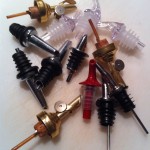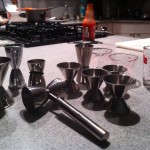JIGGER vs FREE POUR or TOBIN ELLIS, part lll
11 Oct
Recently I assisted a class given by Tobin Ellis at Bridget Albert’s Advanced Academy here in Chicago. The class was not about “mixology” or spirits…it was about efficiency and service behind the bar.
I don’t think there really is any debate on giving good service to ones customers, just a growing emphasis on the lack of it in the bar industry in general and especially the pretentious nature of many of the “craft” cocktail bars that have grown along with the cocktail renaissance.
But, the subject of free pouring and using a jigger behind the bar came up and this caused a ruckus. I have wanted to write on this subject for quite a while now, and this class gives me the perfect opportunity to weigh in on this subject, and agree with and support many of the the assertions made by Tobin, that jiggering is not as accurate as one would think, that jiggering at any speed is not as accurate as a trained free pour, and that it doesn’t offer any special service, in fact it offers slower and even less service in busier bars. This also has the effect of lower bar rings, lower bar tabs, and less money being made by everyone.
I have been in many debates with colleagues over the use of jiggers at bars, especially at busy bars. After having worked in this industry in many varied venues for over 10 years here in Chicago, I can’t think of any reason most bars…busy or not…would employ the use of jiggers to make the bulk of their cocktails and other drinks.
The standard argument for the use of jiggers comes in two forms: They are more accurate and consistent, and they offer a better show or service to the guest.
Let’s look at the idea that they are more accurate and more consistent a little deeper.
On face value it seems to be obvious that a jigger would always be more accurate than free pouring, and it would be more accurate if it was up against a person that wasn’t trained in free pouring. But let’s look at the problems we will encounter in the real world of bartending. Cocktails that use all kinds of measures from 1/4 oz to 3 oz. Standard jiggers have 2 sides that can vary from 2oz/1oz, 1.5 oz/.75 oz, and many other combinations. Small graduated measuring cups are also often employed that allow a little more freedom than non graduated sides.
The accuracy problem with this is threefold. The first is that under stressed/busy conditions, mistakes are prone to happen searching for the correct jigger measure to use. The other is the temptation to start guessing, e.g when you only have a 1.5 oz side, only need an ounce, and just pour to where you think an ounce is. The other is when you do need 1.5 ounces and fill it to the top, making some spillage almost a certainty, or not filling it to the top, to avoid spillage, thus making the pour low. And, finally, the issue of grabbing the wrong jigger in the first place and not catching your mistake. If you have 5 jiggers, and they are only different by .25 or .5 oz, the closer ones start to look pretty much the same, and under stressed conditions mistakes, again are very likely. And, once one starts guessing at all, it makes the entire accuracy and consistency argument moot. In this case the pour is either under or over. losing money for the house if it is over, and cheating the customer if it is under, making the drink inconsistent, and, again, in all cases inaccurate.
To address the issue of these inevitable mistakes, the jiggering process must have a speed limit that can quickly be overwhelmed in busy bar situations or will not be able to keep up with the orders. That issue will be addressed.
The show and service part of jiggering a drink also doesn’t stand up to scrutiny. A bartender can still take his/her time to stir a cocktail and free pour it. In fact, they have more time to attend to the customer and add the truly important steps to building a beautiful cocktail. It still is also a bit of an insult in many circles to jigger a drink for a customer as it looks like you are demonstrating the inhospitable step of measured pouring, ala the Berg System (Berg System Auto Pourer). The level of this indignation is debatable in many places, I grant you, but not the fact that it doesn’t exist to a degree that should be taken in to consideration by any bar owner or bar staff member. Jiggering in a service well, when the bartender is not serving guests, does not make sense from a service stand point again, when the only thing that counts in the well is speed and accuracy of the cocktail.
From the free pour point of view, the first non-truth that jiggering is more accurate is clearly that, not true. Again, at first glance to the layman or untrained free pourer, it looks like a measured pour using a jigger would be laughably more accurate than the “non measured” and unregulated free pour. With a closer look, though, measuring 1.5 oz in a 1.5 oz side of a jigger does not always give you 1.5 oz. Why would that be? In part it is because the measure has to go to the top. This, as I stated earlier, is very difficult to carry to the mixing glass, and if done over the glass, has the effect of nearly forcing the bartender to over pour and spill pour into the glass (by flipping the jigger while still pouring), or under pour if they become aware of this. To get your pour to the top exactly, and on a non flat surface, is not easy at a slow pace, let alone a fast one. But, at any level of speed, free pouring by a trained bartender (it must be a trained professional bartender) is at worst on par with a jigger, but in most real life situations, far more accurate than the jigger. Not only is it more accurate, but it is multiple times faster in busy and chaotic situations, allowing for the bartender to tend to customers and transactions much faster while maintaining that accuracy, and have a more natural flow of service that can easily be accelerated when necessary. It is just so much more natural.
The speed of free pouring is very important to maintaining the bartender’s natural level of concentration and not be a bottleneck that jiggering so often is.
Another question is trust in the free pouring bartender. That again is made moot by the fact that jiggering bartenders can be just as shady or incompetent as any free pouring bartender on giving away the house.
Of course the free pouring bartender must be trained, and tested from time to time. But isn’t this what should be expected of a professional bartender in the first place? Especially in bars where they are looked at as craftsmen. But, unfortunately, the opposite is more often true.
One question keeps popping up to me about this whole issue. Where did this jiggering thing come from, anyway, when most bars were free pour trained 10 years ago? I believe it came from the influx of truly untrained bartenders from the back of the house i.e. cooks, chefs etc.. laymen owners of the new bars who have the same lack of training and knowledge, and the pre-prohibition/craft/mixology cocktail trend and new cocktails with laundry lists of ingredients. It is also an obvious control issue to those who do not understand free pouring or the business of running a busy bar. This is pure speculation, but it comes from a lot of experience in this business.
At the very least, as a fail safe, bartenders should be trained to free pour, even if they work at a jigger only bar. This will allow them to know the accuracy of their pour, even if they are pouring into a jigger…and then they do not ever have to guess what an ounce is in a 1.5 oz jigger.
Free pouring doesn’t have to conjure visions of spring break bartenders, 4 deep bars making buttery nipples and jager bombs, it is for nearly any bar and any clientele. There are always exceptions and places where things may work or not. Every location is unique in taste, image, and environment and clientele. But, that goes for the Berg measured pour system as well. High volume and high bartender turnover would be one place I could think of immediately for that system. But the Berg is even not as fast as true free pouring. Blindly inflicting a jiggering system on your staff and clientele without weighing these details is not good business. But blindly inflicting any system, jiggered, free pour, or Berg, is the wrong way to go as well. If you know you cannot consistently have trained free pouring bartenders behind the stick, then another system…jigger or Berg…is necessary from a pure business standpoint.
As for me, after free pouring for 10 years, I absolutely could not work in a bar that was jigger only. It would be like putting training wheels back on your 10 Speed, and would be utter frustration.
This really has been a subject in need of deeper investigation and debate, and I welcome all comments and rebuttals.
TODD APPEL
Piranha Bros Cocktail and Cocktail Event Consultants
www.toddappel.com


4 Responses to “JIGGER vs FREE POUR or TOBIN ELLIS, part lll”